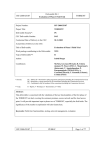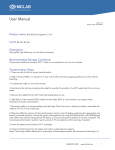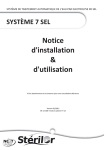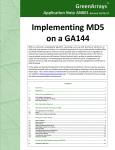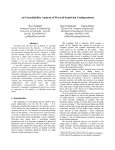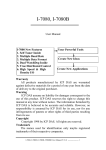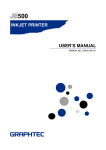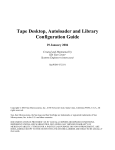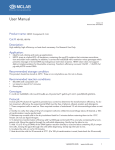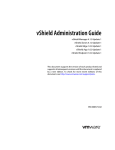Download "user manual"
Transcript
IST-2000-25187 Deliverable D4.5 – part 2 Evaluation of Phase Two Field Trials: Part 2 TORRENT Project Number: IST-2000-25187 Project Title: TORRENT Deliverable Security*: PU CEC Deliverable Number: D4.5 – part 2 Project Document Number: 01-033-v001-wp4-PU-R-d4.5.2 Contractual Date of Delivery to the CEC: 16.02.2004 Actual Date of Delivery to the CEC: Title of Deliverable: Evaluation of Phase Two Field Trials: Part 2 Work package contributing to the Deliverable: WP4 Type of Deliverable**: R Author: Isabel Borges Contributors: M.Potts, B. Voegtli (MCLab); R. Tolstra, H. Singer (tesion); W. Payer (UST); I. Mountzouris (Intracom); A. Costoloni (Flextel); P. Hammer (QMUL); J. Ronan (WIT); I. Borges, C. Rodrigues (PTIN) * Security: PU – Public, PP - Restricted to other programme participants (including the Commission Services) RE - Restricted to a group specified by the consortium (including the Commission Services) CO - Confidential, only for members of the consortium (including the Commission Services) ** Type: R - Report, P - Prototype, D - Demonstrator, O - Other Abstract: This deliverable is concerned with the validation of the key functionalities of the second phase of the TORRENT system. After the delivery of D4.5 part 1, in which ADSL and CATV scenarios, access convergence and user aspects were investigated, this document reports the results of tesion core interconnectivity trial. Keywords: Field trial, evolution, results, testing, evaluation IST-2000-25187 PUBLIC Page 1 of 54 IST-2000-25187 Deliverable D4.5 – part 2 Evaluation of Phase Two Field Trials: Part 2 TORRENT © This Deliverable is Copyright of the TORRENT Consortium IST-2000-25187 whose partners are: Queen Mary and Westfield College (UK) Portugal Telecom Inovação SA (Portugal) Temagon (Greece) Telenor AS (Norway) tesion Communikationsnetze Südwest GmbH (Germany) Flextel SPA (Italy) Intracom SA (Greece) MCLAB GmbH (Switzerland) Universität Stuttgart (Germany) Waterford Institute of Technology (Ireland) IST-2000-25187 PUBLIC Page 2 of 54 IST-2000-25187 Deliverable D4.5 – part 2 Evaluation of Phase Two Field Trials: Part 2 TORRENT Executive Summary This deliverable presents the results and the analysis of results of the phase II - part 2 field trial, namely the UST/MCLab/tesion trial. Chapter one and chapter two will give an introduction and will identify the objectives related with this document. Third chapter focus on the description, configuration and lessons learnt of field trial. The approach used consisted on testing the functionalities of the system, as much as possible as described at D4.4, “Definition of phase II field trials”. The phase II field trial-part 2 had run in the deployed infrastructure connecting MCLab and University of Stuttgart through tesion IP backbone. The results coming from the tesion trial had been inputted to WP2, WP3 contributed to some improvements and to WP5 (Exploitation and Dissemination). Finally, in chapter four, are stated the main conclusions resulting from this work. At the annex all the tests and results are described. IST-2000-25187 PUBLIC Page 3 of 54 IST-2000-25187 Deliverable D4.5 – part 2 Evaluation of Phase Two Field Trials: Part 2 TORRENT Table of Contents Executive Summary ............................................................................................................ 3 1 Introduction ...................................................................................................................... 5 2 Objectives ......................................................................................................................... 5 3 Description of Field Trial.................................................................................................. 5 3.1 tesion Field Trial ........................................................................................... 5 3.1.1 Trial Description - testbed configuration ................................................... 5 Core networks ................................................................................................ 5 3.1.2 Trial results .......................................................................................... 8 3.1.3 Lessons learnt from tesion field trial ........................................................ 8 Flow based priority queuing............................................................................. 10 Core network monitoring ................................................................................. 10 Bandwidth accounting...................................................................................... 10 Failover functionality ....................................................................................... 10 4 Conclusions.................................................................................................................... 13 5 Abbreviations ................................................................................................................. 14 6 References...................................................................................................................... 15 7 Annexes .......................................................................................................................... 16 7.1 Annex 1 - tesion field trial set-up .................................................................. 16 7.2 Annex 2 - List of tests and results ................................................................. 18 7.3 Annex 3 – MCLab/tesion Configurations ......................................................... 53 IST-2000-25187 PUBLIC Page 4 of 54 IST-2000-25187 Deliverable D4.5 – part 2 Evaluation of Phase Two Field Trials: Part 2 TORRENT 1 Introduction The phase II of the Torrent project runs from February 2003 till February 2004 and covers five different countries. Due to delays occurred at tesion trial in the new software releases and E1 cards integration, this trial was delayed till the end of December 2003 to allow the accomplishment of the testing plan [1]. This is the main reason for having two deliverables with the evaluation of phase II field trials. The first one named D4.5 part 1 contains the main results of Temagon, Telenor and PTIN field trials results. [2] This document will report the tesion field trial evaluation and the results of the set of tests that were performed. Those tests have been described as well as the definition of each of the phase II trials at D4.4, “Definition of Phase II trials”, [3]. 2 Objectives The main objective of this deliverable is to present the final results of the tests that were specified in deliverable D4.4, “Definition of Phase II Field Trials” [3], and consequently the evaluation of the TORRENT concept: “To build a test-bed for residential multi-service access networks that will allow the project to demonstrate the benefit of intelligent control, both for the customer and the network operators”. The results presented here are very important since they will allow verifying the interconnection of two LAPs networks through an IP backbone connecting two countries, with the Torrent system selecting the most appropriate core network based on User Preferences. 3 Description of Field Trial This chapter will describe the phase II tesion field trial configuration. 3.1 tesion Field Trial 3.1.1 Trial Description - testbed configuration Core networks The LAP’s will be based in Stuttgart (IND) and Basel (MCLab) and there will be dedicated accesses to different types of networks. This enables the LAP to select and access the most suitable network depending on the requested application. In this way the following interconnections will be realised: • IP over MPLS • IP tunnelled or via VPN • SDH IST-2000-25187 PUBLIC Page 5 of 54 IST-2000-25187 Deliverable D4.5 – part 2 Evaluation of Phase Two Field Trials: Part 2 TORRENT Since tesion is a full-service provider, there is a choice between voice (switch), data and Internet services. The network technologies integrated are ATM, IP, MPLS, SDH and DWDM. This resulted in a network routing as shown below. This enables the testing using IPv4. Figure 1: Network routing One of the items that have gained importance was the implementation of IPv6 instead of IPv4. This of course had also an impact on the field trial between Basel and Stuttgart. During the field trial there were dedicated core routers in Karlsruhe and Stuttgart. The following interconnections were performed: • IP over MPLS The beta-software takes the IPv6 packet and puts a MPLS header on top of this packet. Then it is transferred through the MPLS core network. At the destination this header is removed and the IPv6 packet is transported further to its final destination. • IP tunnelled IST-2000-25187 PUBLIC Page 6 of 54 IST-2000-25187 Deliverable D4.5 – part 2 Evaluation of Phase Two Field Trials: Part 2 TORRENT Originally (IPv4) an IP VPN was planned. The disadvantage for the available IPv6 MPLS SW is that the IPv6 VPN is not available yet. In order to simulate this, the interconnection will be simulated by tunnelling through the network. • SDH This is in fact a leased line and can be considered as a very fast network with optimal QoS. Figure 2: tesion configuration Figure 2 and Figure 3 shows the set-up at MCLab. Figure 3: ADSL Modem Configuration IST-2000-25187 PUBLIC Page 7 of 54 IST-2000-25187 3.1.2 Deliverable D4.5 – part 2 Evaluation of Phase Two Field Trials: Part 2 TORRENT Trial results The main features of this field trial were to test the capabilities of the combined RG and LAP in connection with different types of networks and also, the interconnectivity between LAPs. The aspects and features were: 1. The ability of the RG to be connected to different networks 2. The ability of interworking between RG and LAP and LAP to LAP 3. The ability of the user to select the appropriate network (QoS) 4. Ability to provide system status information to the RG and LAP 5. Ability to suit network operator requirements The results of the tests performed are included in annex 7.1 and 5.2. 3.1.3 Lessons learnt from tesion field trial Apart from the driver issues that occurred on the E1 cards in the LAP and that were finally solved by downgrading the driver software and reconfiguration of the Network access into Framed mode, there have been TCP transmission errors in the direction from Stuttgart to Basel. For these errors, it is unlikely that they are related to a software error in either one of the LAP’s because they occurred only on the first two E1 lines. The third E1 connection did not produce any TCP errors, although it used the same set-up. The only difference was that the third connection was a direct one (SDH), without any intermediate IP routers. Therefore it was concluded, that a faulty or mis-configured intermediary device was disturbing the traffic between Stuttgart and Basel on the first two E1 connections. We assume that this is caused by the X21-G703 converter necessary for the leased lines of the German Telekom. The monitoring on the sending host (Stuttgart LAP) as well as on the receiving host (client PC attached to Basel LAP) resulted in the following course of events from the perspective of the receiving client PC: • Receiving packet with incorrect checksum. • Sending ACK with ACK-No. = Seq.-No. of incorrect packet. • Receiving new packets with new ACK-No. > Seq.-No. of incorrect packet. • Sending 40-50 more ACKs with ACK-No. = Seq.-No. of incorrect packet. • Missing packet is finally received numerous times, but each time with incorrect checksum. The error has been indicated to tesion. However, the early software versions for IPv6 over MPLS did not allow detailed monitoring on the intermediary routers and therefore made it impossible to clearly identify the source of this error. This misbehaviour had only influence on few tests that required long packages. Beside this, the connectivity worked well for the IPv6 traffic. IST-2000-25187 PUBLIC Page 8 of 54 IST-2000-25187 Deliverable D4.5 – part 2 Evaluation of Phase Two Field Trials: Part 2 TORRENT Although we have found a sufficiently reliable set-up procedure for the ADSL links to the LAP, the connectivity, once established, would often only last for a couple of hours, before dropping back into an offline status. Furthermore, the two ADSL links often interfered with each other, meaning that the first link went offline when the second was switched on and vice versa. The situation slightly improved after manually and repeatedly re-inserting the access blades into the LAP. It has to be noted, that these interference errors were not completely reproducible, although they happened frequently. We can only assume, that the interference was caused by a physical electromagnetic shielding problem on the LAP rather than an error or a mis-configuration in the software. Core network policy based routing A central data repository is provided to store user preferences. Choosing a specific core network route was possible • per user, • per service, • in real-time, by changing the related database entry. These changes could be made independently of each other. The results were reflected directly for each newly created session of a specific service, as shown in Figure 4: Core network policy based routing in the tesion Field Trial. Figure 4: Core network policy based routing in the tesion Field Trial IST-2000-25187 PUBLIC Page 9 of 54 IST-2000-25187 Deliverable D4.5 – part 2 Evaluation of Phase Two Field Trials: Part 2 TORRENT Flow based priority queuing This feature would allow the data not only to be routed across different networks, but to be prioritised according to rules given by the user and/or the service used. For example, a video stream might have a higher priority assigned to it than conventional web browsing. In addition, high availability could be achieved by ensuring a certain percentage of the available bandwidth for mission critical applications. The software version available at the tesion Field Trial did not yet provide flow based priority queuing functionality in conjunction with IPv6. Core network monitoring On top of the policy based routing, core network monitoring provides a means of determining in realtime which core network link is congested. The Torrent agent system would then set the routing (as described above in Core network policy based routing) for a specific service requested by the user. Bandwidth accounting In a scenario where multiple clients attached to an RG, using the same ADSL link are accessing highbandwidth services (like video-streaming) simultaneously, as described in F3_Test11, the Torrent system would have to: a. share the available bandwidth equally or according to preferences among the users and b. reject additional requests once the available bandwidth is used up. Bandwidth accounting was not implemented in the Torrent system at the time of the tesion Field Trial. Since there was a lot of available bandwidth (~ 3Mbit/s downstream) on our ADSL link, bandwidth sharing was rarely a problem. However, once the access link was fully congested, additional requests have not been rejected and caused an overall decline in the quality of the running services. Failover functionality Since the Torrent system was designed with the notion of redundant access network technologies, a failover mechanism was needed that would automatically switch to the second access link when the first link was offline. For the tesion Field Trial at MCLab, ADSL was used as the first (main) access link and ISDN as the second (backup) link. Since the LAP did not provide central office ISDN capabilities, we would have been required to set up an external ISDN dial-in device. Unfortunately, MCLab did not have the necessary equipment to make this possible. Knowing that the Torrent system has already been successfully tested to work with ISDN at the previous PTIN Field IST-2000-25187 PUBLIC Page 10 of 54 IST-2000-25187 Deliverable D4.5 – part 2 Evaluation of Phase Two Field Trials: Part 2 TORRENT Trial, we were still able to test if the system was able to correctly monitor the status of the access link and trigger the failover mechanism when needed. Furthermore, the system would have to switch back to the first (main) access link, once it was back online. Both of these conditions were properly handled during our tests, once the RG GUI was started and its failover functionality was activated. In both cases, the user was prompted to confirm the switching on a popup window on the RG. It remains to be discussed, whether it would be desirable to create an alternative mode of operation, where this feature would work fully automatically, without the need for any intervention / confirmation by the user. Consistent front end Besides the underlying functionality, the importance of a central Graphical User Interface (GUI), suitable for the needs of a typical end-user should not be underestimated. A front end for Torrent should take the following cornerstones into account: • Standard conformance – Should follow common interface guidelines. • Intuitiveness, simplicity – Menus, buttons, dialog boxes should be self-explanatory. • Completeness – Relevant information and functionality should all be accessible on the central front end. • Consistency – Menus, buttons, tables, dialog boxes should have a uniform layout. • Input Validation – Invalid user input should be rejected. The current Torrent software leaves a lot of room for improvement in the area of end-user front-ends. The following front-ends, targeted towards the end-user, have been identified in the course of the tesion Field Trial. They provide status information and allow direct user intervention: a) RG: RG GUI – Torrent-specific application to monitor access network status and enable failover functionality. b) LAP: pgaccess database editing application – Allows editing of Torrent user preferences (including core routing information per user and per service) in a tabular view. c) LAP: Management Platform – Provides hardware status information and allows reboot of LAP blades. d) JS500 ADSL modem: web-interface to view and configure ADSL and IP settings. Of these, only a) and b) are related to Torrent specific functionality, whereas c) and d) cover hardware and network configuration. We will primarily concentrate on the former, Torrent related front-ends. IST-2000-25187 PUBLIC Page 11 of 54 IST-2000-25187 Deliverable D4.5 – part 2 TORRENT Evaluation of Phase Two Field Trials: Part 2 The RG-GUI is the only front-end that was developed specifically for Torrent. It shows a complete list of network interfaces on the RG and a list of the currently active connections. The main benefit lies in the failover functionality described above. The second Torrent related front-end, pgaccess, is a generic application designed to view and edit the content of a Postgres database table. Hence, it is not self-describing, lacks a useful layout and labels for the database fields, these are only identified by their relatively short internal names. Furthermore, each database record has to be entered manually, whereas a custom application would ideally offer a structured, hierarchical view (per user, per service). Of course, a custom end-user interface would only make sense when the complete set of underlying Torrent software (priority queuing, core network monitoring) is in place. Only then, the user settings would be detached from explicit routing decisions. Rather, the user, after authenticating, could choose between three or four different quality levels per available service. In a production environment, this application should be available on the RG (i.e. accessed from the LAP via web interface). A User Display Interface developed under WP3 is being tested meanwhile and is deployed at Residential Device. The documentation for the various parts of the Torrent equipment is provided in electronic form, as Adobe Acrobat (PDF) Files. These are the most important documents: • README for the SRM system, by Peter Hamer, QMUL – found on the LAP • Jetspeed 500 User’s Manual – found on the RGs The JS500 User’s Manual contains a complete product description with pictures, screenshots and diagrams whereas the README addresses Torrent specific issues that we are primarily interested in. It contains a detailed and accurate description on the set-up and configuration the Torrent SRM system. In addition to that, there are instructions on how to test the individual parts of the system. The instructions are comprehensive and should be easy to follow for any network operator with reasonable skills in the UNIX environment. They are clearly not addressed towards end-users. IST-2000-25187 PUBLIC Page 12 of 54 IST-2000-25187 Deliverable D4.5 – part 2 Evaluation of Phase Two Field Trials: Part 2 TORRENT 4 Conclusions The decision to use IPv6 for the final Torrent system brought with it a number of significant implications, which also became apparent during the tesion Field Trial. On one hand, the stateless auto configuration capability was very convenient and allowed the devices in the home network on all network interfaces of the RGs to work almost as plug-and-play. Compared to that, the DHCP server that was used for an IPv4 environment was unable to give out IP addresses on more than one network interface at a time. On the other hand, the available firmware of the JetSpeed 500 ADSL modem from Intracom did not support IPv6 natively. An IPv6 on IPv4 tunnel between the RG and the LAP had to be manually configured. Furthermore, a lot of the Torrent functionality that was already implemented in IPv4, was not available in IPv6. One of the obstacles in software development was that the current Linux IPv6 stack is still incomplete in the area of source-based and mark-based routing, connection tracking and NAT. Those are important features, upon which Torrent relies. Without them, flow based priority queuing; core network monitoring and bandwidth accounting are out of reach. However, the missing parts have been identified and working solutions have been found for some of them. Eventually, they might find their way back into the main development tree of the Linux kernel and therefore benefit the overall progress of the IPv6 protocol. IST-2000-25187 PUBLIC Page 13 of 54 IST-2000-25187 Deliverable D4.5 – part 2 Evaluation of Phase Two Field Trials: Part 2 TORRENT 5 Abbreviations ADSL Asynchronous Digital Subscriber Line ATM Asynchronous Transfer Mode ATU-R ADSL Transceiver Unit – Remote End BER Bit Error Rate BERT Bit Error Rate Tester VPI – Virtual Path Identifier CBR Constant Bit Rate CDVT Cell Delay Variation CM Cable Modem CMTS Cable Modem Termination System IPER Internet Protocol (IP) Error Ratio IPLR IP Loss Ratio IPITd IP Inter-arrival Time downstream IPITu IP Inter-arrival Time upstream IPTD IP Transfer Delay L2F Layer Two Forwarding LAP Local Access Point L2TP Layer Two Tunnelling Protocol PCR Peak Cell Rate PPTP Point-to-Point Tunnelling Protocol PVC Permanent Virtual Circuit QoS Quality of Service RG Residential Gateway RTCP Real Time Control Protocol RTT Round Trip Time SCR Sustainable Cell Rate SLA Service Level Agreement SPR Spurious Packet Rate VCI Virtual Channel Identifier VBR Variable Bit Rate VoD Video on Demand VoIP Voice over IP IST-2000-25187 PUBLIC Page 14 of 54 IST-2000-25187 Deliverable D4.5 – part 2 Evaluation of Phase Two Field Trials: Part 2 TORRENT 6 References [1] TORRENT deliverable D4.1, “Metrics of field trials”, November 2001 [2] TORRENT deliverable D4.5 – part1, “Evaluation of Phase II field trials – part 1”, December 2003 [3] TORRENT deliverable D4.4, “Definition of Phase II field trials”, April 2003 IST-2000-25187 PUBLIC Page 15 of 54 IST-2000-25187 Deliverable D4.5 – part 2 Evaluation of Phase Two Field Trials: Part 2 TORRENT 7 Annexes 7.1 Annex 1 - tesion field trial set-up For the Phase II Field Trial (“tesion Field Trial”), it was decided to use IPv6 only. The RGs and the LAP were shipped to Basel and Stuttgart with a linux USAGI kernel and had full IPv6 support builtin. The JS500 ADSL modems to be used as access links from the RGs to the LAP do not support IPv6 yet. Therefore, IPv6-in-IPv4 tunnels were created between the RG Ethernet interfaces and the core blade on the LAP. Since both the RGs and the LAP are based on Redhat Linux, the appropriate standard files, located in /etc/sysconfig/, were used for the IP address configuration. The complete network set-up and IP address scheme can be found in ANNEX 3 at the end of this document. It was originally planned that all the three E1 interfaces would be attached to the core blade of the LAP (Flextel05). However, preliminary tests at Flextel showed that the linux driver software for the E1 card was only able to handle two interfaces at the same time. Hence, the third E1 interface card was attached to a separate processor unit of the LAP (Flextel04). A number of issues were discovered with the driver software for the E1 card from SBE and were finally resolved by using an older version of the driver (1.4). Furthermore, the correct E1 settings had to be found and installed. For the Tesion Field Trial, the configuration was loaded using two scripts, in /home/torrent/ on Flextel05 and Flextel04 respectively: e1_start and e1_stop. These scripts were included in the start-up/shutdown procedure of the LAP. In addition to the three E1-lines for the core network (IPv6 only), the free Ethernet interface on the core blade of the LAP was used for remote administration via IPv4. To enable administrative access from within the TORRENT system, the following NAT rules had to be added to both RGs and the LAP: $ iptables -F; iptables -t nat -F; iptables -t mangle –F $ iptables -t nat -A POSTROUTING -o eth0 -j SNAT --to [192.168.3.2 1 (RG3) | 192.168.4.2 (RG4) | 193.72.156.80 (LAP)] TORRENT specific set-up Before policy-based TORRENT routing could be activated on the LAP, an IPv6 default route had to be added: 1 $ ip –6 add dev hdlc0 1 Included in a script (LAP_custom_config) for custom configuration of the LAP to be executed manually after each startup of the system. IST-2000-25187 PUBLIC Page 16 of 54 IST-2000-25187 Deliverable D4.5 – part 2 Evaluation of Phase Two Field Trials: Part 2 TORRENT Furthermore, the configuration was done according to the README for the SRM system. Some custom configuration was made for the specific setup in Basel: The central configuration Makefile did not foresee parameters for a second RG. Hence, settings for the second RG had to be added manually (i.e. entries had to be added in the TORRENT user_preferences, explicit_up database table) Since the network field (nw) in the user_preferences database table allowed only entries for up to two core networks, the restriction for this field was increased by one. Special set-up procedure for the ADSL connection within the TORRENT system The ADSL link(s) were found to be unstable in the previous TORRENT trials. Connectivity between the LAP and the RG(s) was not always reliable, but the fault was not sufficiently reproduceable to enable it to be located. The following step-by-step set-up instructions have been found to provide reliable IP connectivity over ADSL between the TORRENT LAP and both RGs. It assumes a LAP and modem configuration that is similar to the one shown in Figure 3. Reboot Flextel02 Reboot Flextel03 Power off/on RG3-ADSL modem Delete existing WAN Connection in RG3 modem connection Create a new WAN Connection in RG3 modem connection with the following values: IPoA WAN-IP: 10.0.0.10, Netmask: 255.255.255.0 NAT disabled Power off/on RG4-ADSL modem Delete existing WAN Connection in RG4 modem connection Create a new WAN Connection in RG4 modem connection with the following values: IPoA WAN-IP: 10.0.1.10, Netmask: 255.255.255.0 NAT disabled As an alternative to the manual reconfiguration of the modems, service modemconf restart can be executed on RG3 and RG4. The order in which the first or the second ADSL lines are set up is not critical, but the modems must be rebooted and reconfigured after the restart of the LAP modules. IST-2000-25187 PUBLIC Page 17 of 54 IST-2000-25187 Deliverable D4.5 – part 2 Evaluation of Phase Two Field Trials: Part 2 TORRENT 7.2 Annex 2 - List of tests and results Next tables and figures show the tests description and the results of each test performed at tesion field trial. TC Name: Core Networks dropping-out TC ID: F3_Test1 Test Purpose: Checking the behaviour of the LAP when during data transfer the core network drops out. Test Configuration and Annex 3 Constraints: Test Description: Measurement None equipment used Test Set-up: Annex 3 Test Procedure: Start data transfer from the RG via the LAP to/from core network Disconnect the core network used during this transfer Verdict Criteria: LAP should stop the transfer and switch towards another core network that is available. PASS: see above FAIL: Results: When one of the core network cables is unplugged from the LAP, the following message appears in the LAP’s logfile /var/log/messages/: Flextel05 kernel: hdlc1: Link down Any ongoing traffic that uses this interface stops immediately. There is no switching of networks; the traffic is not routed through another link. Hot-plugging is not supported. After re-plugging the cable into the LAP, the lost connectivity is recovered only after a reboot of the LAP core blade. TC Name: Core Networks missing TC ID: F3_Test2 Test Purpose: Examining the reaction of the LAP when a core network connection is missing at start-up Test Configuration and Annex 3 Constraints: Test Description: IST-2000-25187 PUBLIC Page 18 of 54 IST-2000-25187 Measurement equipment Deliverable D4.5 – part 2 Evaluation of Phase Two Field Trials: Part 2 TORRENT None used Test Set-up: Annex 3 Test Procedure: Disconnect one core network. Start data transfer from the RG via the LAP to/from core network Verdict Criteria: LAP should transfer and switch towards the available core network (if any is available) PASS: see above FAIL: Results: The following message does NOT appear, when the cable to the according network is unplugged before startup: Flextel05 kernel: hdlc0: Link up (peer uptime …) There is no indication about the missing core network. Routing through one of the remaining available core networks is only possible when changing the user preferences accordingly. There is no automatic switching towards the available core network. TC Name: Two RGs towards 2 different Core Networks TC ID: F3_Test5 Test Purpose: Connect 2 RGs to the LAP and try to simulate traffic that requires routing via 2 different core networks. Test Configuration and Annex 3 Constraints: Test Description: Measurement None equipment used Test Set-up: Annex 3 Test Procedure: Start data transfer from 2 RGs via the LAP to/from 2 core networks with 2 PCs Verdict Criteria: The LAP should route each PC towards the required networks PASS: Both networks should be accessed FAIL: IST-2000-25187 PUBLIC Page 19 of 54 IST-2000-25187 Results: Deliverable D4.5 – part 2 Evaluation of Phase Two Field Trials: Part 2 TORRENT Two IPv6 capable websites are accessed from home-pc1 (2001:9e8:2:aaaa:2c0:26ff:feff:e0ee), attached to RG3, and from homepc2 (2001:9e8:2:aaba:230:4fff:fe11:4a92), attached to RG4: http://www.kame.net and http://melon.mclab.ch. The user preferences are set by directly editing the table explicit_up of the database user_preferences on the LAP, using the program pgaccess as suggested by the documentation. For home-pc1, the nw field is set to 1 (line 8 in Figure 5). For home-pc2, the nw field is set to 2 (line 9 in IST-2000-25187 PUBLIC Page 20 of 54 Figure 5). To be able to access the websites, 2001:9e8:2:aaa0::1 and IST-2000-25187 Deliverable D4.5 – part 2 Evaluation of Phase Two Field Trials: Part 2 TORRENT Figure 5: User Preference database Entries The log entries for home-pc1 indicate that the traffic is routed correctly through nw1 (the first core network – hdlc0), as configured in the user_preferences database (see Figure 5): Nov 25 12:02:31 Flextel05 httpd: TORRENT/DEBUG: mark_outgoing_stream insert=sudo /opt/torrent/local/iptables/sbin/ip6tables -I OUTPUT -t mangle -p tcp --src 2001:9e8:0:5::2 --sport 33290 -j MARK --set-mark 256 Nov 25 12:02:31 Flextel05 httpd: TORRENT/DEBUG: mark_outgoing_stream system()=0 Nov 25 12:02:31 Flextel05 httpd: TORRENT/DEBUG: mark_outgoing_stream delete=sudo /opt/torrent/local/iptables/sbin/ip6tables -D OUTPUT -t mangle -p tcp --src 2001:9e8:0:5::2 --sport 33290 -j MARK --set-mark 256 Nov 25 12:02:31 Flextel05 kernel: TORRENT: /proc/torrent/nw1 matches pkt src=2001:9e8:0:5:0:0:0:2 Nov 25 12:02:31 Flextel05 kernel: TORRENT: ... pkt will be routed as if from 0:ffff:ffff:ffff:ffff:ffff:ffff:fff1 The log entries for home-pc2 indicate that the traffic is routed correctly through nw2 (the second core network – hdlc1): IST-2000-25187 PUBLIC Page 21 of 54 IST-2000-25187 Deliverable D4.5 – part 2 Evaluation of Phase Two Field Trials: Part 2 TORRENT Nov 25 12:02:50 Flextel05 httpd: TORRENT/DEBUG: mark_outgoing_stream insert=sudo /opt/torrent/local/iptables/sbin/ip6tables -I OUTPUT -t mangle -p tcp --src 2001:9e8:0:5::6 --sport 33297 -j MARK --set-mark 512 Nov 25 12:02:50 Flextel05 httpd: TORRENT/DEBUG: mark_outgoing_stream system()=0 Nov 25 12:02:50 Flextel05 httpd: TORRENT/DEBUG: mark_outgoing_stream delete=sudo /opt/torrent/local/iptables/sbin/ip6tables -D OUTPUT -t mangle -p tcp --src 2001:9e8:0:5::6 --sport 33297 -j MARK --set-mark 512 Nov 25 12:02:50 Flextel05 kernel: TORRENT: /proc/torrent/nw2 matches pkt src=2001:9e8:0:5:0:0:0:6 Nov 25 12:02:50 Flextel05 kernel: TORRENT: ... pkt will be routed as if from 0:ffff:ffff:ffff:ffff:ffff:ffff:fff2 Nov 25 12:02:50 Flextel05 kernel: TORRENT: ... pkt routed via dev hdlc1 Nov 25 12:02:50 Flextel05 kernel: TORRENT: nw2 fn=cee87840 The chosen routing as indicated by the log entries in /var/log/messages on the core blade of the LAP was also confirmed by tcpdumps, taken on each of the core interfaces during data transfer. Conclusion: The test was successful; traffic for both RGs was routed according to the user preferences. TC Name: Access to 2 Core networks from 1 RG TC ID: F3_Test6 Test Purpose: Connect 2 PCs to 1 RG a try to access 2 core networks via the LAP Test Configuration and Annex 3 Constraints: Test Description: Measurement None equipment used Test Set-up: Annex 3 Test Procedure: Start data transfer from the RG via the LAP to/from 2 core networks with 2 PCs connected to 1 RG. Verdict Criteria: The LAP should route each PC towards the required networks PASS: both PCs should be able to access the requested network FAIL: Results: IST-2000-25187 See bellow PUBLIC Page 22 of 54 IST-2000-25187 Deliverable D4.5 – part 2 Evaluation of Phase Two Field Trials: Part 2 TORRENT The same procedure as for test F3_Test5 was followed. However, only 1 RG (RG4) was used. Homepc2 (2001:9e8:2:aaba:230:4fff:fe11:4a92) and home-pc3 (2001:9e8:2:aabb:230:65ff:fe02:28fc) were used to access the above mentioned websites. The user-preferences were set to use nw2 for home-pc2 and nw3 for home-pc3. The log-entries for home-pc2 showed the following entries: Nov 25 12:30:03 Flextel05 httpd: TORRENT/DEBUG: mark_outgoing_stream insert=sudo /opt/torrent/local/iptables/sbin/ip6tables -I OUTPUT -t mangle -p tcp --src 2001:9e8:0:5::6 --sport 33358 -j MARK --set-mark 512 Nov 25 12:30:03 Flextel05 kernel: TORRENT: ... so routed via dev=lo Nov 25 12:30:03 Flextel05 kernel: TORRENT: normal routing for pkt from src=8085:efc7:0:0:e80b:2bc0:98d8:ffbf Nov 25 12:30:03 Flextel05 kernel: TORRENT: ... dst=0:0:0:0:0:0:0:1 Nov 25 12:30:03 Flextel05 kernel: TORRENT: ... so routed via dev=lo Nov 25 12:30:03 Flextel05 kernel: TORRENT: normal routing for pkt from src=8085:efc7:0:0:e80b:2bc0:98d4:ffbf Nov 25 12:30:03 Flextel05 kernel: TORRENT: ... dst=0:0:0:0:0:0:0:1 Nov 25 12:30:03 Flextel05 kernel: TORRENT: ... so routed via dev=lo Nov 25 12:30:03 Flextel05 httpd: TORRENT/DEBUG: mark_outgoing_stream system()=0 Nov 25 12:30:03 Flextel05 httpd: TORRENT/DEBUG: mark_outgoing_stream delete=sudo /opt/torrent/local/iptables/sbin/ip6tables -D OUTPUT -t mangle -p tcp --src 2001:9e8:0:5::6 --sport 33358 -j MARK --set-mark 512 Nov 25 12:30:03 Flextel05 kernel: TORRENT: /proc/torrent/nw2 matches pkt src=2001:9e8:0:5:0:0:0:6 Nov 25 12:30:03 Flextel05 kernel: TORRENT: ... pkt will be routed as if from 0:ffff:ffff:ffff:ffff:ffff:ffff:fff2 Nov 25 12:30:03 Flextel05 kernel: TORRENT: ... pkt routed via dev hdlc1 Nov 25 12:30:03 Flextel05 kernel: TORRENT: nw2 fn=cee87840 The log-entries for home-pc3 showed the following entries: Nov 25 12:26:42 Flextel05 httpd: TORRENT/DEBUG: mark_outgoing_stream insert=sudo /opt/torrent/local/iptables/sbin/ip6tables -I OUTPUT -t mangle -p tcp --src 2001:9e8:0:5::2 --sport 33350 -j MARK --set-mark 256 IST-2000-25187 PUBLIC Page 23 of 54 IST-2000-25187 Deliverable D4.5 – part 2 Evaluation of Phase Two Field Trials: Part 2 TORRENT Nov 25 12:26:42 Flextel05 kernel: TORRENT: ... so routed via dev=lo Nov 25 12:26:42 Flextel05 kernel: TORRENT: normal routing for pkt from src=e02a:52c5:0:0:e80b:2bc0:f8d7:ffbf Nov 25 12:26:42 Flextel05 kernel: TORRENT: ... dst=0:0:0:0:0:0:0:1 Nov 25 12:26:42 Flextel05 kernel: TORRENT: ... so routed via dev=lo Nov 25 12:26:42 Flextel05 kernel: TORRENT: normal routing for pkt from src=e02a:52c5:0:0:e80b:2bc0:f8d3:ffbf Nov 25 12:26:42 Flextel05 kernel: TORRENT: ... dst=0:0:0:0:0:0:0:1 Nov 25 12:26:42 Flextel05 kernel: TORRENT: ... so routed via dev=lo Nov 25 12:26:42 Flextel05 httpd: TORRENT/DEBUG: mark_outgoing_stream system()=0 Nov 25 12:26:42 Flextel05 httpd: TORRENT/DEBUG: mark_outgoing_stream delete=sudo /opt/torrent/local/iptables/sbin/ip6tables -D OUTPUT -t mangle -p tcp --src 2001:9e8:0:5::2 --sport 33350 -j MARK --set-mark 256 Nov 25 12:26:42 Flextel05 kernel: TORRENT: /proc/torrent/nw1 matches pkt src=2001:9e8:0:5:0:0:0:2 Nov 25 12:26:42 Flextel05 kernel: TORRENT: ... pkt will be routed as if from 0:ffff:ffff:ffff:ffff:ffff:ffff:fff1 Nov 25 12:26:42 Flextel05 kernel: TORRENT: ... pkt routed via dev hdlc0 Nov 25 12:26:42 Flextel05 kernel: TORRENT: nw1 fn=cee87800 The chosen routing as indicated by the log entries in /var/log/messages on the core blade of the LAP was also confirmed by tcpdumps, taken on each of the core interfaces during data transfer. Conclusion: The test was successful; traffic for both home-pcs was routed according to the user preferences. TC Name: Intelligent functions in the LAP TC ID: F3_Test7 Test Purpose: This test is intended to check if the LAP can determine which core network to use. The decision on the LAP is based on information about load and costs of the networks and which services are over which accessible network. Test Configuration and Annex 3 Constraints: Test Description: IST-2000-25187 PUBLIC Page 24 of 54 IST-2000-25187 Deliverable D4.5 – part 2 Evaluation of Phase Two Field Trials: Part 2 TORRENT Measurement equipment None used Test Set-up: This test uses the Phase 1 configuration. Test Procedure In the productised versions, there will be a database, which provides the LAP with information about core network, services, cost and load. At the moment it is not possible in an easy way to get online information about the different core networks (except link down or up). For the test we defined some services: Video1: accessible over core network 1 Video2: accessible over core network 1 and 2, lower costs on 2 In addition we define traffic load situations: Situation1: network 1 is high loaded so that video1 can't be played. Situation2: network 1 is low loaded so that video1 can be played. Situation3: network 2 is high loaded and network 1 is low loaded, so that video2 can only be played over network 1. Situation4: both networks are low loaded. Verdict Criteria: PASS: if in situation... 1: video1 is not being offered as available service. 2: video1 is being offered as available service and can be played. 3: video2 is offered and will be played over network 1. 4: video2 is offered and will be played over network 2. Video 1 will be played over network1. See bellow Results: The test could not be performed as planned, because the agent system does not yet monitor the network load of the different core networks. However, a number of streaming tests were conducted over the different core networks: MPEG movies of different quality and data rate were accessed from within the home network in Basel: 1) video1 - 81.2 Kbytes/sec (00’45) 2) video2 - 130.5 Kbytes/sec (04’25) Both of these movies were hosted by the apache web server on the two LAPs: The LAP in Basel (2001:9e8:2:aaa0::1) The LAP in Stuttgart (2001:9e8:2:aa05::5) VLC Version 0.62 was used with the following settings: IST-2000-25187 PUBLIC Page 25 of 54 IST-2000-25187 Deliverable D4.5 – part 2 Evaluation of Phase Two Field Trials: Part 2 - TORRENT http proxy configured on 2001:9e8:2:aaa0::1 port 8080 - “Force IPv6” was switched on - Caching value was set to 1200 ms TORRENT Results: video server 1 a Played properly, with minor artifacts and outages of > 0.5 seconds 1 b Usually stopped after 12-25 seconds * 2 a Artifacts, interruption after 35 seconds, audio speed changing, video stuck after 02:18, frequent audio interruptions, audio stuck after 04:10 2 b Usually stopped after about 12 seconds * * Due to data corruption problems on the first two core networks. After analysing the TCP packets on both the sender (Stuttgart-LAP MPLS interface) and the receiver (home-pc1), the cause of the problem was found to be the reception of a packet with an incorrect checksum, after about 10 seconds of the transfer. The sending host re-sends these packets, but they again arrive broken at the receiver (incorrect checksum). Hence, there must have been a disturbing factor within the network. TC Name: Throughput TC ID: F3_Test10 Test Purpose: Throughput (RG to LAP to Core network) Test Configuration and Annex 3 Constraints: Test Description: Measurement Iperf equipment used Test Set-up: Annex 3 Test Procedure: Start data transfer from the RG via the LAP to/from core network with a PC connected to RG. Verdict Criteria: Measure the maximum throughput achieved. PASS: Maximum throughput should reach at least 1.5Mbit/s FAIL: Results: IST-2000-25187 See bellow PUBLIC Page 26 of 54 IST-2000-25187 Deliverable D4.5 – part 2 Evaluation of Phase Two Field Trials: Part 2 TORRENT Measurements were made with iperf in both client and/or server mode on RG3 and RG4 The LAP in Basel (IPv6 only) The LAP in Stuttgart (IPv6 only) TCP data was sent for one hour into both directions from a) to b) and b) to c). The results are as follows: Throughput between the RGs and the Basel-LAP Figure 6: Bidirectional IPv4 TCP Throughput between RG3 and LAP IST-2000-25187 PUBLIC Page 27 of 54 IST-2000-25187 Deliverable D4.5 – part 2 Evaluation of Phase Two Field Trials: Part 2 TORRENT Figure 7: Bidirectional IPv6 TCP Throughput between RG3 and LAP IST-2000-25187 PUBLIC Page 28 of 54 IST-2000-25187 Deliverable D4.5 – part 2 Evaluation of Phase Two Field Trials: Part 2 TORRENT Figure 8: Bidirectional IPv4 TCP Throughput between RG4 and LAP IST-2000-25187 PUBLIC Page 29 of 54 IST-2000-25187 Deliverable D4.5 – part 2 Evaluation of Phase Two Field Trials: Part 2 TORRENT Figure 9: Bidirectional IPv6 TCP Throughput between RG4 and LAP The throughput between the LAPs in Basel and Stuttgart was at 1.87 Mbit/sec in both directions on all three E1-lines. TC Name: Predictable quality TC ID: F3_Test11 Test Purpose: This test is intended to ensure that the quality of the VoD service is predictable, even with varying loads on the network. It will test that CAC mechanisms are functioning correctly, and that bandwidth sharing (notably on the ADSL access link) gives bandwidth fairly to multiple services sharing the link. Test Configuration and Annex 3 constraints: Test Description: IST-2000-25187 PUBLIC Page 30 of 54 IST-2000-25187 Measurement Deliverable D4.5 – part 2 Evaluation of Phase Two Field Trials: Part 2 TORRENT None equipment used Test Set-up: This test uses the Phase 1 configuration. Test Procedure: To perform this test, it is assumed that the ADSL access link is the bottleneck, and can support 2, but not 3 simultaneous video transfers. One video film is selected from terminal 1, and viewing starts. A second (different) video is selected from the 2nd terminal, and viewing starts. The quality of the first video should not reduce, and both transmissions should be equally good. The user attempts to select a film from terminal 3. This is rejected, and a suitable message should be returned. The telephone is used, and this call is accepted. Verdict Criteria: Is the 2nd video accepted? Does the quality of the 1st video remain unchanged? Is the quality of the 2nd video identical to that of the 1st video? Is the 3rd video selection rejected? Results: See bellow The test was done using the same videos as in F3_Test7. The videos were played simultaneously from a client-pc and two laptops, each attached to RG4 via WLAN, to ensure that one single ADSL line was used. The videos were accessed only from the LAP in Basel, since the core network is not relevant for this test. The results are as follows: Is the 2nd video accepted? Yes, the 2nd video is accepted as demanded. However, on a linux client pc, using VLC 0.62, there are significant delays of up to ~40 seconds until the video finally starts. This behaviour was observed independently of whether the client was the first or second one requesting the video. Does the quality of the 1st video remain unchanged? No apparent changes to the 1st video were observed. Is the quality of the 2nd video identical to that of the 1st video? video2 had random audio or video drop-outs and some artifacts, which happened independently of whether another client was accessing a video at the same time; hence it was not related to the ADSL bottleneck. Is the 3rd video selection rejected? IST-2000-25187 PUBLIC Page 31 of 54 IST-2000-25187 Deliverable D4.5 – part 2 Evaluation of Phase Two Field Trials: Part 2 TORRENT No, there was no rejection, but quality suffered noticeable on accessing the 3rd video. TC Name: Communication test between RG and LAP TC ID: F4_Test7 Test Purpose: This test is intended to verify the Communication between RG and LAP. Does the LAP notify congestion on link(s) to the core network? Is this information given the RG? (The correctness of the information will be tested in test 15. The focus here is on the communication with the RG) Is there any information available on the RG, which can be used to indicate charging to the user? Failures detected by the LAP or RG - can they be reported on the user site? Can any information about the available services (maybe user profilespecific) be fetched by the user from the RG? Does the agent platform provide information to the users, regarding the charging of the services? Test Configuration and Phase 1 configuration constraints: Test Description: Measurement equipment None used Test Set-up: This test uses the Phase 1 configuration. Test Procedure: The listed situations will be simulated. It will be checked if any information corresponding to the situation is available from the RG. The form of the information for test phase 1 is unimportant (bits, numbers, MIB, messages...) but it must be described in the system documentation. Simulated situations: Congestion on a link to the core network LAP overloaded LAP not reachable Running service has stopped on the server (or server down) Protocol errors on a running service stream Congestion on a link to the core network Link failure on the access networks Add and remove services on the LAP IST-2000-25187 PUBLIC Page 32 of 54 IST-2000-25187 Deliverable D4.5 – part 2 TORRENT Evaluation of Phase Two Field Trials: Part 2 Different VoD connections will be established. Depending on the con-tract between user and provider there should available on the RG information on time, data volume, speed, price per data unit, price per time which allowed to calculate the costs of the running service. Verdict Criteria: A clear information should be available one each listed situation. Results: See bellow Most of the required functionality was not implemented during the Field Trial. Of the simulated situations, only one produced an output on the RG when the RG GUI was running: Link failure on the access networks When the ADSL link was interrupted, the popup window shown in Figure 10 appeared on the RG. Figure 10: RG Information Message to the User that the LAP is not reachable TC Name: Quality of the service data stream TC ID: F4_Test8 Test Purpose: This test analyses the quality of the transfer of the service data. What is the throughput at all (RG and LAP), what is the bottleneck? Does the throughput of a service correspond to the commitments? How much transfer delay do we have over LAP and RG? What is the delay variation? Is the delay variation acceptable for VoD services? Test Configuration and Phase 1 configuration constraints: Test Description: Measurement equipment Protocol analyser with 2 interfaces used IST-2000-25187 PUBLIC Page 33 of 54 IST-2000-25187 Test Set-up: Deliverable D4.5 – part 2 Evaluation of Phase Two Field Trials: Part 2 TORRENT This test uses the Phase 1 configuration. In addition a protocol analyser will be monitoring the traffic. One interface will be connected between VoD server and LAP (core network). The second is connected on the home network after the RG. Test Procedure Service traffic (VoD stream) will be analysed together with background traffic looking on throughput, delay and delay variation and losses. The test will be repeated several times with different amount of background traffic. (Access link load in steps from 0% up to 100%). In each step also a new service will be started. Any changes in the traffic flow during the setup procedure of the new service will be recorded. Verdict Criteria: For the VoD application the most important criteria is the delay variation. A big variation needs a large buffer on the client site especially for the audio stream. But large buffers mean large memory and additional delay. The delay itself is not so relevant for a VoD service. It will be more critical in test phase 2 when VoIP will be used. PASS: as long as the link is not overloaded the VoD application must run without any failures. No data are lost. (Main focus on the audio). To setup a new service should not influence the already running services. Results: Result will be reported to the developers. This test could not be done, because no protocol analyser was available. Throughput was measured in F3_Test10. TC Name: Negotiation speed (QoS specification, switching on failure/congestion for fully congested core network access TC ID: F6_Test2 Test Purpose: Negotiation speed (QoS specification, switching on failure/congestion) for fully congested core network access: should notify and take alternative (if possible) Test Configuration and Annex 3 Constraints: Test Description: Measurement To be decided equipment used Test Set-up: IST-2000-25187 Annex 3 PUBLIC Page 34 of 54 IST-2000-25187 Test Procedure: Deliverable D4.5 – part 2 Evaluation of Phase Two Field Trials: Part 2 TORRENT Start data transfer from the RG via the LAP to/from fully congested core network access. Verdict Criteria: Should notify user and take an alternative route (if possible) PASS: see above FAIL: Results: The test could not be done, since the required core network bandwidth monitoring was not yet implemented during the tesion Field trial. TC Name: Negotiation speed for fully free core network access TC ID: F6_Test3 Test Purpose: Negotiation speed (QoS specification, switching on failure/congestion) for fully free core network access Test Configuration and Annex 3 Constraints: Test Description: Measurement To be decided equipment used Test Set-up: Annex 3 Test Procedure: Start data transfer from the RG via the LAP to/from fully free core network access Verdict Criteria: Connection should be made successfully with set-up times < N ms PASS: see above < N ms in 90 % of the attempts FAIL: Results: The test could not be done, since the required core network bandwidth monitoring was not yet implemented during the tesion Field trial. TC Name: Negotiation speed between RG and LAP TC ID: F6_Test4 Test Purpose: This test is intended to measure the times that are used for the different negotiations between RG and LAP and the correctness of the commitments of the following actions or events. Service requested with grantable QoS parameters. Updating the service list offered to the user, after a service will be new established or released. For example a user which is choosing a video while another user starts a video should get the information that now IST-2000-25187 PUBLIC Page 35 of 54 IST-2000-25187 Deliverable D4.5 – part 2 Evaluation of Phase Two Field Trials: Part 2 TORRENT only medium quality instead of high quality will be performed. This process needs information about the core and the access network. Link failure during running applications with Switching to ISDN is possible, Switching is not possible. Switch back after link is up again (if possible to reduce costs) Test Configuration and Annex 3 constraints: Test Description: Measurement equipment Protocol analyser for monitoring the committed QoS parameters. used Test Set-up: This test uses the Phase 1 configuration. Test Procedure: System information with time stamps will be taken from the RG and LAP. For this case a system log, which includes information about events and status, must be available on the LAP and RG. The time differences will be calculated between the start and reaching the end status of the action. By analysing the monitored traffic at the user site the committed QoS parameters will be proved. The used service will be VoD. Events which needs any negotiation between RG and LAP: 1) A user chooses a film. Starting action: sending a request. Ending action: connection to the video server is established or action failed. 2) A load change will be simulated with background traffic in such way that a video can be offered in higher quality and the other way round. The load change will be simulated once in the access network and once in the core network. 3) A service (VoD) is running on the broadband link. The link will be disconnected. a) The connection will be taken over from to the ISDN link. b) There are not enough resources available; the user gets an error message. 4) Starting situation: A VoD service is taken over to ISDN after a broken ADSL link. After reconnection of the ADSL the service should be switched back again (to reduce the costs). IST-2000-25187 PUBLIC Page 36 of 54 IST-2000-25187 Verdict Criteria: Deliverable D4.5 – part 2 Evaluation of Phase Two Field Trials: Part 2 TORRENT 1) Service is established in an acceptable time for users (couple of seconds). (Looking to Test 2, 10 seconds from the application layer is acceptable) 2) The update of the availability of the services should be in the same time as the other response times (<= 10 sec.) 3) a) The running service will be switched. This involves that there are no data losses and the data flow is not more delayed than a VoD client can bridge using the local buffer. b) The user gets the message about the broken link in an acceptable time (couple of seconds). 4) Same as 3a) Most of the functionality required for this test was not implemented Results: during the tesion Field Trial. Only test 4) (switching to ISDN and back) was implemented on the RG side. In order to function properly, the RG’s GUI had to be started and the “Failover Functionality” in the Menu “Settings” has to be activated. The link failure on the ADSL line was already tested in F4_Test7 and the resulting popup window is shown in Figure 10. A second popup window appears after reconnecting the ADSL line as shown in Figure 11. Figure 11: RG Information Message to the User that the LAP is reachable again TC Name: LAP-core network interconnection status TC ID: F8_Test1 Test Purpose: To test user feedback and rerouting capabilities in case of core network failure. IST-2000-25187 PUBLIC Page 37 of 54 IST-2000-25187 Test Configuration and Deliverable D4.5 – part 2 Evaluation of Phase Two Field Trials: Part 2 TORRENT Annex 3 Constraints: Test Description: Measurement None equipment used Test Set-up: Standard operation of RG and LAP with active traffic. Test Procedure: Cut off one of the core networks when the system is running normally. Verdict Criteria: Is the lost connectivity reported to the customer? Is traffic re-routed to another core network, when requested by the customer? Results: As tested in F3_Test1, lost connectivity (link down) is only reported in the logfile of the LAP. There is no user notification and the traffic is not rerouted upon user request. The procedure for choosing a different core network to route the traffic through is described in F3_Test5. IST-2000-25187 PUBLIC Page 38 of 54 IST-2000-25187 Deliverable D4.5 – part 2 Evaluation of Phase Two Field Trials: Part 2 TORRENT TC Name: Notification of fully congested links to core network access TC ID: F8_Test2 Test Purpose: Notification of fully congested links to core network access Test Configuration and Annex 3 Constraints: Test Description: Measurement None equipment used Test Set-up: Annex 3 Test Procedure: Cause the accesses to the core network(s) to be congested, and then start a connection to core network. Verdict Criteria: Notification to the user should be generated PASS: see above FAIL: Results: There was no notification to the user of fully congested core network links. TC Name: Core network utilisation/pricing feedback TC ID: F8_Test3 Test Purpose: To test the usability of core network utilisation/pricing feedback. Test Configuration and Phase 2 configuration; constraints as described above Constraints: Test Description: Measurement None equipment used Test Set-up: Basic phase 2 configuration LAP connected to core networks Utilisation/pricing simulated information fed into LAP from at least one of the core networks Type of utilisation/pricing simulated information: Utilisation Costs of bandwidth/service probably depending on time of day Cost of excess bandwidth IST-2000-25187 PUBLIC Page 39 of 54 IST-2000-25187 Test Procedure: Deliverable D4.5 – part 2 TORRENT Evaluation of Phase Two Field Trials: Part 2 Basic test: Put RGs and LAP in operation Ensure for connectivity to core networks (Regular) gathering of utilisation/pricing simulated information Logging of utilisation and pricing information Enhanced test (depending on availability of enhanced functionality): Feed utilisation/pricing simulated information into database Present utilisation/pricing simulated information to user for service selection Use utilisation/pricing simulated information in routing decisions Indicate changes in pricing to user Verdict Criteria: Is utilisation/pricing information available to the LAP? Is utilisation/pricing information fed back to the user? Is utilisation/pricing information used accordingly in traffic routing decisions? Results: There was no pricing feedback implemented as of this date. Therefore this test could not be done. TC Name: Diagnosis (provision of system status information to user) TC ID: F8_Test4 Test Purpose: This test is intended to ensure that both normal and fault information from the system is presented accurately to the user in an understandable manner. The information should identify clearly which part of the system was responsible for any loss of quality. Test Configuration and Annex 3 constraints: Test Description: Measurement None equipment used Test Set-up: IST-2000-25187 This test uses the Phase 1 configuration. PUBLIC Page 40 of 54 IST-2000-25187 Test Procedure: Deliverable D4.5 – part 2 Evaluation of Phase Two Field Trials: Part 2 TORRENT The following circumstances are expected to produce information to the end-user, that originates from – or is passed transparently through - the RG and/or LAP: In the Normal State Status messages that the RG and LAP are operating correctly Service offerings that are available Service currently in use User’s current profile Charging information (on request) Error Conditions: RG is powered down LAP is powered down RG is faulty LAP is faulty LAP CAC reports that a new session cannot be accepted because the link to the core network has insufficient capacity The developers of the RG and the LAP should provide further information about the messages that they propose to pass to the end user, and the system operator. The format of the messages and the presentation must be harmonised. The above list is not expected to be exhaustive. All of the above conditions (and any others identified later) will be induced, and it will be checked if the appropriate message is received. Further diagnosis messages will appear in Phase 2, since more services will be available, and they will be able to take a choice of routes on both the access link and towards the core network. In these cases, messages should inform the user about the route that is being taken (if different to the normal one) and any cost/quality implications that this will have. Verdict Criteria: Are all the given diagnostic messages produced in accordance with the associated conditions? Results: See bellow The GUI-based application on the RG (Figure 13: RG Status GUI) provides some basic information about connectivity, which is limited to the RG and its direct links: IST-2000-25187 PUBLIC Page 41 of 54 Deliverable D4.5 – part 2 IST-2000-25187 • Evaluation of Phase Two Field Trials: Part 2 TORRENT RG and/or LAP are in the Normal State On the bottom on the window a status message is shown (“Connection to LAP is up”) • Status messages that the RG and LAP are operating correctly See above. No further status messages are available. • Service offerings that are available This can be seen in the database table view on the LAP (see Figure 5) • Service currently in use Some (limited) information is available on the RG GUI in the window “connection tracking”. • User’s current profile Information is not available. • Charging information (on request) Information is not available. • RG is powered down Information is not available. • LAP is powered down This will be shown in the status message of the RG GUI • RG is faulty Information (limited to connectivity is available in the window “Interface List”. • LAP is faulty This is limited to the status of the connectivity to the RG (shown in the status message of the RG GUI) TC Name: TC ID: IST-2000-25187 Ease of installation F12_Test3 PUBLIC Page 42 of 54 IST-2000-25187 Test Purpose: Deliverable D4.5 – part 2 Evaluation of Phase Two Field Trials: Part 2 TORRENT This test is intended to ensure that the installation of the equipment (terminals, home network cabling, RG, access network, LAP, access to the core network, and application server (ie. for Phase 1, VoD) is easy to install. The home network connectivity and terminals should be straightforward to install and configure by a normal user, but bearing in mind that this equipment is not a commercial one. The RG should require a minimum of configuration, and written instructions should be available, and accurate. The access network (ie. for Phase 1, ADSL) should require little or no manual adjustment, and the LAP should boot into a stable state, ready to accept configuration commands after it has been powered up. Instructions for configuring the LAP should be available, and accurate. Test Configuration and Annex 3 constraints: Test Description: Measurement None equipment used Test Set-up: IST-2000-25187 This test is used to install the Phase 1 configuration. PUBLIC Page 43 of 54 IST-2000-25187 Test Procedure: Deliverable D4.5 – part 2 TORRENT Evaluation of Phase Two Field Trials: Part 2 The Phase 1 scenario is installed in accordance with all available written instructions. The RG (ADSL modem interface) is connected to the LAP (DSLAM interface) via a specified length of copper-pair 3 PCs are connected to the home network side of the RG via an Ethernet cable A regular ISDN telephone is connected to the home network side of the RG via the S0 bus interface The LAP is connected to 3 external interfaces, representing access to 3 unique core networks The VoD server is connected to one of these interfaces The system is powered up After allowing time for the equipment to settle, configuration of the terminal, RG and LAP is performed in accordance with the available instructions After all configuration has been completed, the VoD service should be selectable on any of the 3 user terminals, and the user should be able to select and view one of the films offered Verdict Criteria: Do all the items of equipment settle into a fault-free state on powering up? Is configuration information available for all the devices, and are they straightforward Are the operations under the control of an end-user easy enough for a non-technical person to follow? Does the whole system function properly after installation and configuration? Results: See bellow. Some points were different in the tesion Field Trial from the described scenario: Not all home PCs were connected via an Ethernet cable, only two of them. One was connected via Wireless LAN. There was no dedicated VoD server, videos were all accessed through an apache webserver (http) on one of the LAPs or on an IPv6 server at MCLab. Verdict Answers: IST-2000-25187 PUBLIC Page 44 of 54 IST-2000-25187 Deliverable D4.5 – part 2 Evaluation of Phase Two Field Trials: Part 2 TORRENT Do all the items of equipment settle into a fault-free state on powering up? Once the configuration has been done according to the manuals and the custom steps described in “Testbed configuration”, a fault-free condition was usually reached. However, towards the end of the Field Trial, there have been problems when both DSLAM modules on the LAP were started. The ADSL lines could not be initialised and the status LED on the JS500 modem kept blinking red. An interference between the two blades containing the DSLAM modules was observed: When restarting one of the blades, the ADSL line belonging to the second DSLAM was reaching a fault state, indicated by a red blinking LED. Is configuration information available for all the devices, and are they straightforward? Configuration information is available and accurate on a generic level. However, a custom setup, like the one in the Tesion Field Trial required more in-depth analysis of the individual parts of the system. Furthermore, an overall documentation, covering the TORRENT system as a whole would have been desirable. Such a documentation could have included a meaningful overview as well as IP addressing and routing issues. Are the operations under the control of an end-user easy enough for a non-technical person to follow? A consistent user interface does not exist for the end-user. Specific applications to control the functionality exist on the LAP and on the RGs. The LAP contains a web-interface to get status informations and perform basic management functions, like rebooting the individual blades (Figure 12). Switching of the core network is done with pgaccess, a GUI-based database viewing and editing application that resides on the LAP (Figure 5). A custom GUI-based application exists on the RGs (Figure 13). It shows the connected network interfaces and provides the access link failover functionality described earlier The JS500 modems have a web interface that shows some status information and allows the IP configuration of the device (Figure 14) Does the whole system function properly after installation and configuration? Once installed and configured, the system works properly, with the limitations described earlier. IST-2000-25187 PUBLIC Page 45 of 54 IST-2000-25187 Deliverable D4.5 – part 2 Evaluation of Phase Two Field Trials: Part 2 TORRENT Figure 12: Flextel Management Interface Figure 13: RG Status GUI IST-2000-25187 PUBLIC Page 46 of 54 IST-2000-25187 Deliverable D4.5 – part 2 Evaluation of Phase Two Field Trials: Part 2 TORRENT Figure 14: ADSL Modem Web Configuration Tool IST-2000-25187 PUBLIC Page 47 of 54 IST-2000-25187 Deliverable D4.5 Evaluation of Phase II Field Trials – part 2 TORRENT TC Name: Ease of installation Plug and Play of gateway and other user equipment TC ID: F12_Test4 Test Purpose: Obtain an impression of how difficult it is to install the RG itself, and also how difficult it is to interface this with other user equipment Test Configuration and Annex 3 constraints: Test Description: Measurement None equipment used Test Set-up: Test Procedure: When received the RG will be unpacked. The documentation will be read, and the system will be set up. The amount of skill needed, and the time used will be basis for the evaluation. Next other user equipment will be connected. Is it possible to connect the equipment, does it “plug and play”, which reconfigurations has to be performed? Verdict Criteria: It should be possible to set up the RG without special skills, and it should function with its default services within a reasonable time after unpacking. Normal phones and PC equipment should “plug and play”. Other types of equipment such as gateways to other networks and special servers should be possible to connect. Results: See bellow After unpacking the PC and attaching the monitor, mouse and keyboard, the startup procedure was straightforward. A working RedHat Linux operating system was pre-installed and preconfigured. IP address and routing configuration had to be made manually from scratch by changing the RedHat specific configuration files. An extensive manual for the JS500 modem plus additional information was found in electronic form on both RGs. Attaching the JS500 modem was no problem using the manual. The web configuration tool (Figure 14) was used for the IP address configuration of the modem. Special care had to be taken for the DHCP server setup. The provided script caused all the attached routes to be lost. Therefore, an alternative script was created to fix this. However, this was only required for IPv4. IST-2000-25187 PUBLIC Page 48 of 54 IST-2000-25187 Deliverable D4.5 Evaluation of Phase II Field Trials – part 2 TORRENT Conclusion: Without connectivity to the LAP and IPv4-based DHCP, a fully capable system was available out-of-the-box, with standard Ethernet and WLAN interfaces for the home network pre-configured. The setup procedure for this took only a few minutes. Later, the ADSL connectivity and correct IP configuration was more complex and could only be done after the rest of the TORRENT system was properly configured. TC Name: Reliability (error tolerant and stable, self-monitoring) TC ID: F12_Test5 Test Purpose: This test is intended to assess the reliability of the system, specifically concerning the features of: Error tolerance (does the system allow unusual inputs? Does the system “hang”?) Stable (does the system “crash”? Does the system react in an inconsistent manner? Does the system sometimes work, sometimes not?) Self-monitoring (if the RG or LAP fails, are the operator and the user informed? Is the message/indicator appropriate and correct?) Test Configuration and Annex 3 constraints: Test Description: Measurement None equipment used Test Set-up: This test uses the Phase 1 configuration. Test Procedure: During all the tests, the system will be monitored for error tolerance, stability and self-monitoring. Any such occurrences will be recorded. Verdict Criteria: Are commands accepted that are not in the instructions? Are parameters, or parameter values, accepted that are not in the instructions? Does any part of the system crash, or become in a state where no inputs are accepted, and a re-start is necessary? Does the system sometimes react differently to the same commands? If the RG or LAP fails, are the operator and the user informed? Are failure messages/indicators appropriate and correct?) IST-2000-25187 PUBLIC Page 49 of 54 IST-2000-25187 Results: Deliverable D4.5 Evaluation of Phase II Field Trials – part 2 TORRENT Error tolerance: The applications used for TORRENT allowed only valid input data (e.g. numeric core network number was required) Stability: There was some stability issues described in the chapter “Testbed configuration”. Apart from that, the system was stable for days on end. Self-monitoring: As described in F3_Test1, link failures on one of the core networks was tracked by the LAP’s system log. In addition, the failover functionality described in F4_Test7 and F6_Test4 provided a means of switching the access network in case of a link failure. TC Name: Ease of use/control/maintenance of System TC ID: F12_Test7 Test Purpose: This test is intended to assess the ease of use of the system Test Configuration and Phase 1 configuration constraints: Test Description: Measurement None equipment used Test Set-up: This test uses the Phase 1 configuration. Test Procedure: The users and system operators will be questioned about their perception of the “ease of use”, “ease of control” and “ease of maintenance”. In the Phase 2 user trials, this test implies the need for clear instruction manuals, a user-friendly interface, and that users must set up the installation themselves. In Phase 1, this is more a validation of the availability of instructions from the RG and LAP developers how to control their equipment. The control and configuration may be at a relatively low-level, but the information provided by the developers should still be accurate and capable of being followed easily. Verdict Criteria: Are written instructions available? Is the control and configuration possible, following the information provided by the developers? IST-2000-25187 PUBLIC Page 50 of 54 IST-2000-25187 Results: Deliverable D4.5 Evaluation of Phase II Field Trials – part 2 TORRENT In the absence of a single consistent user interface, this test could not be conducted with typical end-users. With the current system, an end-user should at least be able to set up an RG on his/her own (without connectivity to the LAP however). TC Name: Management platform TC ID: F13_Test2 Test Purpose: Management platform (simulate alarms in LAP/Network and check generated reports, alarms & warnings) Test Configuration and Appendix A Constraints: Test Description: Measurement None equipment used Test Set-up: Annex 3 Test Procedure: Simulate alarms in LAP/Network and check generated reports, alarms & warnings. Verdict Criteria: PASS: Correct alarms and warnings should be generated FAIL: Results: The management platform (see Figure 15) controls mainly the overall hardware status of the particular blades within the LAP. Therefore, if i.e. one of the access network blades is reported as “down”, it means that the blade itself is switched off completely. It does not show whether there is really connectivity or not (software). IST-2000-25187 PUBLIC Page 51 of 54 IST-2000-25187 Deliverable D4.5 Evaluation of Phase II Field Trials – part 2 TORRENT Figure 15: Flextel Management Interface (for the Chassis and Modules) Figure 16: Flextel Management Interface (for the PSUs, Fans and Modules) IST-2000-25187 PUBLIC Page 52 of 54 IST-2000-25187 Deliverable D4.5 Evaluation of Phase II Field Trials – part 2 TORRENT 7.3 Annex 3 – MCLab/tesion Configurations Figure 17: MCLab configuration IP Configuration LAP Tesion Testbed Basel No. DNS-Name Interface IPv4-Address 1 Flextel01 eth0 192.168.89.33 2 eth1 192.168.41.1 3 ipb0 192.168.5.1 4 Flextel02 eth0 192.168.47.1 5 ipb0 192.168.5.2 6 Flextel03 eth0 192.168.45.1 7 ipb0 192.168.5.3 8 Flextel04 atm0 10.0.0.1 9 Flextel04 eth0 192.168.43.10 10 hdlc0 192.168.110.9 11 ipb0 192.168.5.4 12 Flextel05 atm0 10.0.0.1 13 atm1 10.0.1.1 14 eth0 192.168.43.1 15 hdlc0 192.168.120.9 16 hdlc1 192.168.130.9 17 ipb0 192.168.5.5 18 sit1 19 sit2 IP Configuration for Tesion (Basel Router) 20 21 IP Configuration RG3 and RG4 22 RG3 sit1 23 eth0 192.168.3.2 24 eth1 192.168.13.1 IST-2000-25187 IPv6-Address Remarks 2001:8a0:102:13::1/64 Virtual Interface 2001:9e8:2:1::2/126 2001:9e8:2:1::6/126 Virtual Interface Virtual Interface 2001:9e8:0:5::2/126 2001:9e8:0:5::6/126 2001:9e8:2:1::5/126 2001:9e8:2:aaa0::1/60 2001:9e8:2:aab0::1/60 NP1 (MPLS IPv6) NP2 (MPLS IPv6 tunneled) NP3 (SDH) Static Route – 2001:9e8:2:1::5/125 via 2001:9e8:2:1::6 Tunnel interface for RG3 Tunnel Interface for RG4 2001:9e8:0:5::1/126 2001:9e8:0:5::5/126 NP1 (MPLS IPv6) NP2 (MPLS IPv6 tunneled) 2001:9e8:2:aaa0::2/60 Tunnel Interface for LAP WAN -> JS500 ADSL modem LAN Interface 2001:9e8:2:aaaa:1/64 PUBLIC Page 53 of 54 IST-2000-25187 25 26 27 28 29 RG4 wlan0 sit1 eth0 eth1 wlan0 IST-2000-25187 Deliverable D4.5 Evaluation of Phase II Field Trials – part 2 192.168.31.1 192.168.4.2 192.168.14.1 192.168.41.1 2001:9e8:2:aaab::1/64 2001:9e8:2:aab0::2/60 2001:9e8:2:aaba::1/64 2001:9e8:2:aabb::1/64 PUBLIC TORRENT WLAN Interface Tunnel Interface for LAP WAN -> JS500 ADSL modem LAN Interface WLAN Interface Page 54 of 54






















































